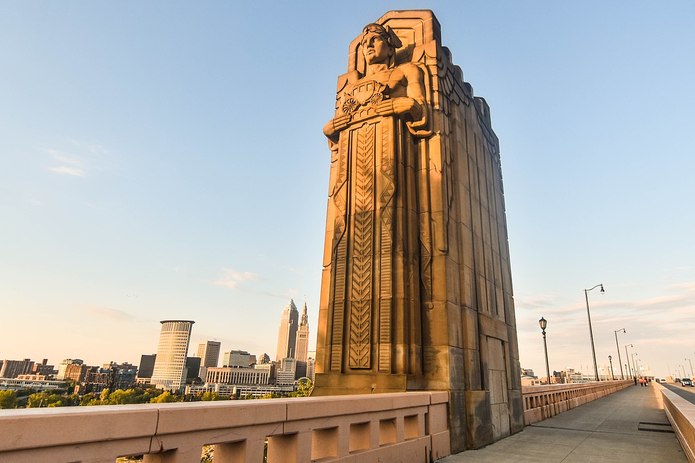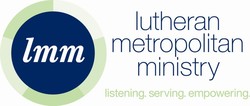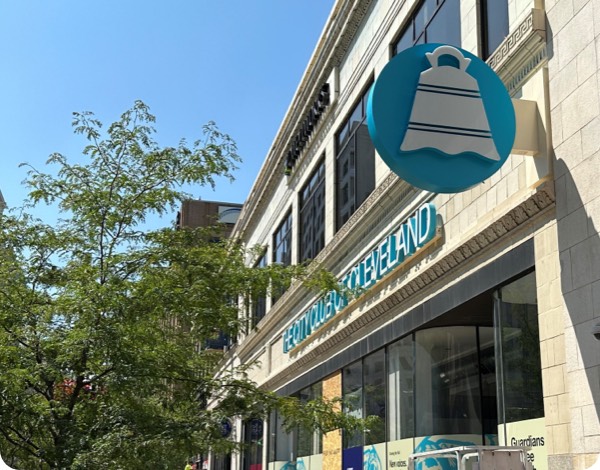Wednesday, April 29, 2020
Past Reopening to a Full Economic Recovery
by Kevin J. Kelley, President, Cleveland City Council

The Defining Challenge of our Times
On Monday, Governor DeWine announced plans for the much-anticipated re-opening of our economy which has been essentially shut down by the coronavirus pandemic. But as we contemplate the long term health of our economy there are two sets of questions facing elected officials. The first set of questions are questions of how we safely reopen our economy. The second question involves what actions elected officials and others can take to ensure the long term health of the economy.
On the first question, the reopening of our economy should be guided by the recommendations of the public health community. In Ohio and Cuyahoga County, we are fortunate to have a highly intelligent and compassionate public health community and most Ohio elected officials have wisely heeded their advice. There is nothing worse than elected officials pretending to be public health officials. There is a role for politicians, but it is not masquerading as doctors.
The real job for public officials is how to lead our communities out of this crisis. Are we truly ready to learn from this pandemic? Can we build on the assets that we have and finally confront the systemic problems that have been holding back Cleveland for years?
Cleveland’s Economy Has Both Tremendous Strengths and Pervasive Weaknesses
The coronavirus pandemic has shined a bright light on both the strengths and the weaknesses of our economy and our institutions. It has highlighted much of what we do well, and what we should build on.
Our Greatest Strength is Our People
Clevelanders are tough enough to meet any challenge, and our response to this crisis proved that yet again.
When the residents of Cleveland were called upon to adapt to the new health policies and procedures put out by the state, we didn’t complain- we got to work. All over Cleveland, essential workers rolled up their sleeves and got the job done. The coronavirus crisis has shown that we are fundamentally strong people. Cleveland remains strong both in spirit and resiliency. During this pandemic, we have proven to be caring people. Example upon example clearly demonstrates our ability to care for one another. And, like most, I have nothing but respect and admiration for those front line health care workers, first responders, grocery store workers, postal workers, waste collectors, and all essential workers that risked their lives to keep our community safe and healthy.
I saw the stress and concern of frontline healthcare workers through my wife, Elizabeth, who works as a nurse. She spent many days and nights screening patients for COVID-19 at the hospital she works at. And as this developed, none of them were sure exactly what the risks were and what she may have been exposed to. Like other essential workers, she has had to be resilient and adapt daily to changing policies and procedures based on new information. And there are thousands of stories just like that across our city.
Cleveland has endured so many challenges in the last 100 years, from depression to default to the housing crisis, but we never lost heart or hope. And our citizens’ response to this latest crisis shows that our determination and heart is as strong as ever. And we are going to need that spirit to pull ourselves out of the economic chaos caused by this virus.
Cleveland is the health care capital of the world, and this crisis proved it.
No other American city our size has the wealth of medical institutions and resources that Cleveland has, and it was on display during this crisis.
Our world-class medical institutions are so prominent in our lives, sometimes we lose sight of the fact that medicine has become perhaps our greatest strength. As the Coronavirus crisis unfolded, Cleveland health care leaders were sought out time after time to provide guidance at the national level. At the same time, our health care systems put aside rivalries and effectively coordinated their resources.
We saw our hospital and healthcare system quickly adapt to the crisis. We saw the system working closely with the public health community to share information, determine the needed hospital beds, develop protocols, redeploy staff, set up auxiliary hospital space, and generally provided a sound response to the coronavirus pandemic. We proved to the world that Cleveland is the healthcare capital of the world. Clearly, this is an asset that we can build on.
Cleveland has a vibrant and innovative advanced manufacturing base
Cleveland manufacturing has helped respond to national crises before, and they are doing it again now
Although Cleveland indeed lost manufacturing jobs in the seventies and eighties, the remaining companies survived by being agile and innovative. And just as our local manufacturing pivoted to help with military production during World War 2, our local firms quickly moved to respond to this challenge.
Working together voluntarily through an effort called the Ohio Manufacturing Alliance to Fight COVID-19, our manufacturing sector retooled their factories to produce hand sanitizer, ventilators, sterilization equipment, and personal protective equipment for front-line medical workers. As important as the information technology sector is to the future of the country, our manufacturing base is an essential ingredient in having a balanced economy. The manufacturing sector offers well-paying jobs and opportunities for growth. The kind of innovation and retooling shown by the manufacturing sector is the kind of innovation that we need to build upon as we emerge from this crisis.
Indeed, the pandemic has shined a light on many of the assets of our community and our economy. These are only a few examples of the strengths of our community and people caring for people. But a sustainable recovery will require building on these assets. But the real challenge we face coming out of this pandemic is to strengthen our economy, we have to stop looking past those conditions that are holding us back; our digital divide, our failure to train our workforce for available jobs, and our disparities in health outcomes.
THE PANDEMIC NEEDS TO BE A CALL TO ACTION
As much as Cleveland’s greatness shined in working through the pandemic, Cleveland can only hope to thrive again if we use this crisis as a wake-up call to stop looking past systemic issues that are hindering our growth and progress. I would argue that we have an obligation to do so. To be clear, when speaking of the economy and our institutions, the coronavirus crisis did not reveal anything new. It did not tell us anything that we didn’t already know. Rather, it shined a light on how the existing weaknesses of our economy are exacerbated during a crisis. For some of the major systemic issues, they all have these commonalities: 1) they are well known; 2) they have been a part of the civic dialogue; 3) solutions are available; and 4) we have tolerated them.
We have expressed our gratitude to all of the front line health workers, first responders, and essential workers during this pandemic. So to honor their work and sacrifice as well as honor those that we have lost, we must learn from this and grow. This pandemic and the resulting recession have proven that we can no longer look past known systemic issues if we hope to recover and thrive. We can’t keep doing what we are doing and hope to recover. The following are just a few examples of well known systemic issues that if solved could be the basis for a thriving, sustainable, and inclusive Cleveland.
Digital Divide
We sent our children home to learn remotely, knowing that approximately 12,000 scholars had no internet access. If this is not a call to action, I don’t know what is.
The concept of digital divide is not new. It was not revealed by the pandemic. But the pandemic certainly exposed just how unprepared we were and how important it is for this community to finally resolve this inequity.
The most egregious example of our failure to solve the digital divide was illustrated through our children. We have sent our children home from school. We have set up virtual learning platforms that are expected to replace the classroom. But we did so knowing that an estimated 12,000 CMSD students do not have a reliable internet service and reliable device. How can we reasonably expect them to succeed under these circumstances? Is this a tolerable situation? This is not acceptable. And while school children are an obvious example of this injustice, much of the workforce that was told to work from home is lacking in the broadband access that is an expectation of working from home.
My wife and I are fortunate enough to be the parents of five daughters, and the youngest of them, Erin, is a 4th grader at a CMSD school. Beth and I sat down with her when her school closed, shared our laptop with her, and tried to help her with the virtual learning process. The weekly CMSD learning packet relies on access to the internet. But does every CMSD family have that technology or that opportunity?
Sadly, the concept of a digital divide in Cleveland has been a part of the civic dialogue for well over a decade. That digital access is essential to growth and success is well settled. That children and job seekers need access to information, knowledge, and opportunity is undisputed.
And solutions are available. Many communities across the nation and even in Ohio have effectively deployed broadband access to all of their citizens. In Cleveland, the Old Brooklyn community has deployed a free WiFi service that makes high-speed broadband service available to citizens within a 4.5 square mile area of the City. And the nonprofit DigitalC has developed a model to provide affordable broadband for most of Cleveland. So there are solutions; there is a deployment strategy that is right for Cleveland.
But while the problem has been identified and discussed, the will to force a solution has not been there. Hopefully, the pandemic has proved the will to finally solve this problem. We have known about it and tolerated it. With most of our K-16 students learning from home, for at least that remainder of this year and the next academic year undetermined, there has never been a more urgent time to finally address the inequity we refer to as the digital divide.
Workforce Development and The Skills Gap
How can thousands of unfilled, high paying jobs co-exist with unemployment and underemployment in the same community?
Similar to the digital divide, our failure to train our workforce for the available jobs and emerging employment trends is not a new problem. But with much of the reopening conversation involving getting back to work, the next logical questions have to be, what work will be left to get back to and whether our workforce has the skills to adapt to the new economy, whatever that may be. The problem of not properly equipping our citizens with the skills to compete has been a part of the civic discussion for many years. Yet very little progress has been made. When the economy reopens, jobs will likely be scarce. That is why it is more important than ever that this community prioritizes the education and training of our citizens so that they can succeed in an economy dominated by IT, healthcare, manufacturing, and skilled trades.
The flip side of the workforce development issue is the skills gap employers face in seeking qualified employees for currently available jobs. So if the failure to properly train our citizens has failed them, the resulting lack of qualified candidates for available jobs has failed industry. Taken together, we all lose. Yet again, this is not new information. This has been well documented for years. Team NEO has published an extremely detailed, well-sourced, well-researched publication titled Aligning Opportunities in Northeast Ohio. Its basic conclusion is that there is an extreme imbalance between the region’s workforce and jobs available, especially in technology, healthcare, manufacturing, and skilled trades. Again, this wasn’t caused by the coronavirus pandemic. But emerging from this likely recession is going to depend on this community’s ability to effectively prepare our workforce for the post-pandemic economy.
Taken together, the workforce development/skills gap issues should be shocking: unfilled jobs in the same community with a high unemployment and underemployment rate. Making this problem more vexing are additional barriers to work such as transportation and child care barriers, just to name a few obstacles. But solutions exist. And however challenging, solving this issue is the best means of developing family-sustaining incomes. So we can look at this as a problem that is too hard to solve, or we can treat solving the workforce/skills gap issue as an essential building block to a sustainable economy.
Disparities in Health Outcomes
This pandemic shined a bright light on the racial and income disparities in our health outcomes. And as with other issues discussed above, healthcare inequality was not caused by the pandemic. We have all been aware that health outcomes in Cleveland are largely determined by one’s zip code for many years. So it shouldn’t have come as a surprise that COVID-19 struck black and brown people at a higher rate than Caucasians.
The only remaining question is whether we continue to tolerate this disparity or use this as an opportunity to finally prioritize disparities in health outcomes. If our public health community and hospital systems could quickly adapt all of their processes in a coordinated response to the pandemic, then certainly this great system of hospitals and public health officials can find the same sense of urgency to solve disparities in health outcomes.
Conclusion: Smart Cities Will Make the Most of this Crisis
Every city across the globe has been forced to confront the coronavirus pandemic. The early stages of the crisis have been dominated by debates over closings, social distancing, and other public health questions. As we emerge from the quarantine period, each city must make a choice- will they try to return to business as usual, or will they make the most of this moment, and turn a tragedy into a chance for reinvention.
Cleveland cannot afford to be a status quo city in the wake of this crisis. Cleveland can succeed, but only by having the will to build on our strengths and solve those problems that have been hindering our growth since long before the pandemic. Only an honest appraisal of both our enduring strengths and persistent weaknesses can make Cleveland into the city we all know it can be.





